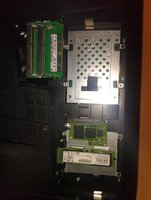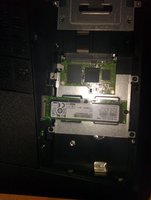Some might already know I (again) messed up my Linux SSD.
Does anyone know a quick fix for my problem?
The BIOS doesn't recognize my SSD any more a boot device.
I have a Windows SSD as well but as long as the broken Linux SSD is in the computer I can't even enter the Boot menu manually. Without Windows boots. Sometimes... I already had the case where I was able to enter the menu.
I already did boot from a boot USB stick and reinstalled grub again (with configuration).
Partition flag is set as boot.
I'm booting from gpt UEFI. Using Arch Linux.
Otherwise the SSD is fully working. I can access it via my Pandora and an USB to SSD adaptor.
How I caused this problem?
I had slow boot and I wanted to do a file check on my boot partition. I checked with gparted (no error). That's it.
If anyone knows a quick fix i'd be glad for a hint. Else don't bother. It's not a Linux support forum here.
My next step would be to delete the boot partition and set it up again.
As the SSD is working I can make a full backup and get am list of everything I've installed.
EDIT: Solved
Does anyone know a quick fix for my problem?
The BIOS doesn't recognize my SSD any more a boot device.
I have a Windows SSD as well but as long as the broken Linux SSD is in the computer I can't even enter the Boot menu manually. Without Windows boots. Sometimes... I already had the case where I was able to enter the menu.
I already did boot from a boot USB stick and reinstalled grub again (with configuration).
Partition flag is set as boot.
I'm booting from gpt UEFI. Using Arch Linux.
Otherwise the SSD is fully working. I can access it via my Pandora and an USB to SSD adaptor.
How I caused this problem?
I had slow boot and I wanted to do a file check on my boot partition. I checked with gparted (no error). That's it.
If anyone knows a quick fix i'd be glad for a hint. Else don't bother. It's not a Linux support forum here.
My next step would be to delete the boot partition and set it up again.
As the SSD is working I can make a full backup and get am list of everything I've installed.
EDIT: Solved
Everything was done via arch-chroot using an USB stick.
1: Reformatted the partition with mkfs.
2: Installed grub again using the (grub-install --target=X86_64-efi --efi-directory=/boot --bootloader-id=arch_grub --debug --recheck
-> System booted into Grub command line
3: mkdir /boot/EFI/boot
4: cp /boot/EFI/arch_grub/grubx64.efi /boot/EFI/bootx64.efi
-> Familiar Grub boot screen
-> Could start Kernel
-> Busy taks and boot into administrator mode
(Luckily I messed up my Linux before and could imagine what the problem was reading the error messages)
5: The boot partition had the wrong UUID in fstab
6: lsblk -f gave me the UUID
7: nano /etc/fstab fixed it
-> Reboot
-> Victory
1: Reformatted the partition with mkfs.
2: Installed grub again using the (grub-install --target=X86_64-efi --efi-directory=/boot --bootloader-id=arch_grub --debug --recheck
-> System booted into Grub command line
3: mkdir /boot/EFI/boot
4: cp /boot/EFI/arch_grub/grubx64.efi /boot/EFI/bootx64.efi
-> Familiar Grub boot screen
-> Could start Kernel
-> Busy taks and boot into administrator mode
(Luckily I messed up my Linux before and could imagine what the problem was reading the error messages)
5: The boot partition had the wrong UUID in fstab
6: lsblk -f gave me the UUID
7: nano /etc/fstab fixed it
-> Reboot
-> Victory
Last edited:



